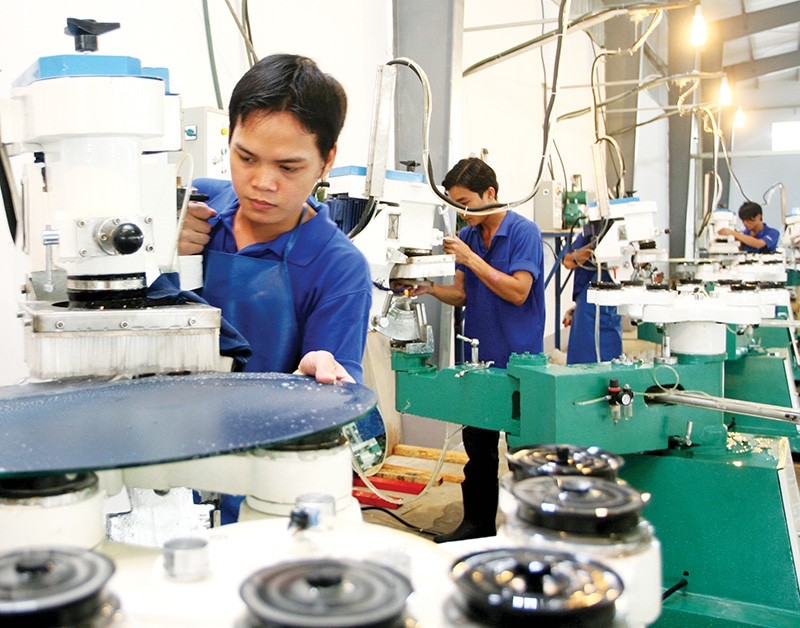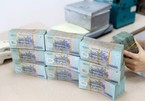 |
| Through the SMEDF, small- and medium-sized enterprises can take advantage of preferential interest rates. Photo: Le Toan |
Small and medium-sized enterprises (SMEs) account for around 98.1 per cent of the nearly 800,000 businesses operating in Vietnam and are undoubtedly the backbone of the domestic economy. However, many of them have encountered enormous roadblocks in securing timely financing, despite playing a major role in economic growth and job creation.
As part of the Ministry of Planning and Investment (MPI), the Small- and Medium-sized Enterprises Development Fund (SMEDF) was specifically designed for SMEs planning to create products in value chains or expand their footprint.
The fund, created in 2016, has become a trustworthy partner on granting preferential tailor-made loans to help SMEs improve.
The SMEDF is also cooperating with other local commercial lenders, such as Military Bank, Saigon-Hanoi Bank, and BAC A BANK to provide top-notch lending services for this segment.
Specifically, SMEs can enjoy preferential interest rates, as well as various support from the fund, which is currently mulling over implementing a direct lending scheme to better assist companies.
The direct process is based on Decree No.39/2019/ND-CP from 2019 on the organisation and operation of the SMEDF; and Circular No.14/2020/TT-BKHDT on handling risks in the fund’s direct lending activities, as well as direct lending regulations and processes.
One of the key challenges that SMEs in Vietnam continue to face is limited access to credit. Recent research on SMEs in Vietnam conducted by John Rand and Finn Tarp at the University of Copenhagen found that about 25 per cent of SMEs face credit constraints and that the demand for credit among small businesses is 115 per cent greater than supply.
This is the reason why informal credit markets are playing such a large role for many SMEs, particularly for micro and small businesses, according to the United Nations Development Programme (UNDP).
The unmet financing needs of SMEs in developing countries are estimated at around $5.2 trillion annually. During the pandemic, access to financing from traditional banks has dried up even more, which has contributed to slowing economic growth.
Elsewhere, a prominent example is Japan Finance Corporation which specialises in supporting unsecured loans of small enterprises and startups.
“Lending for startups is considered an extremely risky sector, because there is no financial data, no transaction results, and reliable information. That’s why we could not apply the conventional approaches to startup financing,” said Nguyen Trong Hieu, lecturer from Hanoi University of Business and Technology.
“I believe the SMEDF could learn from the experience of Japanese peers, especially with their major focus lying on the visions of entrepreneurs and their solid business plans,” he added.
Nguyen Duc Thuan, director of the Vietnam Environment Protection Fund under the Ministry of Natural Resources and Environment, shared his experience on loans disbursement and examination. “Before granting loans to any businesses, funds must ensure checking information from the Credit Information Centre, as well as double-check their financial capacity and debt payment ability. As a state-owned fund, the SMEDF should take a very cautious view on conducting evaluation and loan appraisals processes.”
Do Thi Bich Mai, director of VietinBank's operation division, noted that SMEs in Vietnam usually depend on internal funds or borrowing from entrepreneurs, relatives, and friends. “Thus, they are in need of public support and venture finance. The pandemic has further decreased the cash flow and working capital of SMEs,” Mai said. “Even some major asset management companies are more interested in purchasing sour debts associated with large collateral from banks. That could pose a real challenge for funds like the SMEDF if any non-performing loans incur.”
Conventional methods of commercial banks, which specialise in large corporations, are more likely to help lenders gaining a solid return, while providing loans for SMEs might be less profitable and more troublesome.
Jonathan Pincus, economist at the UNDP, pointed out some challenges for SMEs accessing bank credit, including their low value of physical assets, principal-agent problem, and over-leveraging during the coronavirus pandemic.
“Public support in SME financing has been around for a while. For instance, in India, its ministry of MSME’s credit guarantee scheme will guarantee up to 85 per cent of unsecured loans with a maximum of $300,000,” said Pincus. “SMEs could enjoy their preferential conditions from the Small Industries Development Bank of India. Yet, the scheme also presents issues, such as low processes and non-tradable guaranteed loans.”
Tran Duy Dong - Deputy Minister of Planning and Investment
Over the last three years of supporting finance for small- and medium-sized enterprises (SMEs), we can see some positive outcomes as some SMEs have already received preferential loans from the fund and doing well, with increased profits and more jobs created.
The performances of some are even good enough to pay back their loans earlier than expected. Moreover, such initial capital can also lure more resources to help SMEs.
In 2020, the government issued Resolution No.84/NQ-CP on tasks and solutions for dealing with difficulties in business operations, promoting disbursement in public investment, and ensuring public order and safety during the pandemic. It also accelerated the SMEDF’s operation and support for SMEs to overcome difficulties.
Last June the SMEDF reduced interest rates to 2.16 per cent for short-term loans, and 4 per cent for middle- and long-term ones to accelerate the recovery and development of SMEs. This confirms the determination of the government and the Ministry of Planning and Investment (MPI) to promote all SMEs’ potential and improve their competitiveness.
In order to improve business climate and develop the private sector, the laws on investment, enterprises, and support for SMEs have been perfecting policies supporting them in various aspects like approaching credit and developing human resources, business management, and innovation, as well as on developing supply chains and regional partnerships.
To resolve the difficulties on approaching capital for SMEs, the SMEDF under the management of the MPI was established with the Decision No.601/QD-TTg in 2013, with VND2 trillion ($87 million) of chartered capital. In May 2019, the government issued Decree No.39/2019/ND-CP on the organisation and operation of the SMEDF with its major functions of lending, financing, and supporting SMEs.
Caitlin Weisen - Resident representative in Vietnam, United Nations Development Programme
It is important to have a full understanding of the financial ecosystem for SMEs in Vietnam, and the strategic role that a new funding window can play in leveraging existing domestic sources of capital – both public and private – to meet the changing needs of SMEs.
This is necessary so that more robust, effective, and sustainable lending facilities are developed to ease credit constraints for SMEs. Furthermore, it will also help to define a niche role for the direct lending window for this fund, with clear target groups and criteria for monitoring and measuring success.
Besides this, given the increasing demand for green, sustainable finance to address pressing climate challenges, the fund should have a strong focus on green development and recovery. Identifying clear target groups and criteria to ensure responsible, inclusive, and green business models and products is essential.
The UNDP, in partnership with the MPI, is working with the Ministry of Agriculture and Rural Development to accelerate technical and financial solutions for green agriculture supply chains, with a focus on shrimp and dragon fruit. We are also cooperating with the Agency for Enterprise Development of the MPI to develop a programme for supporting private enterprises to use sustainable business models and cleaner production technologies.
The limited earmarked state finances should be used effectively to catalyse large investments from the private sector that can be blended with other sources of public finance. The government should also accelerate the introduction of innovative finance schemes such as green bonds and carbon trading schemes so that SMEs can tap into this new finance channel. It is important to have transparent and robust operational guidelines and criteria to gain confidence of SMEs for accessing the fund, as well as to co-invest in potential projects and leverage other credit sources. VIR
Song Huong

SMEs want sharper interest rate cuts
Small and medium enterprises (SMEs) need capital to revive their production, but cannot access bank loans or receive support from local credit guarantee funds.

HCM City unveils $517 million aid package for SMEs
Ho Chi Minh City is set to roll out a second COVID-19 aid package worth 12 trillion VND (517 million USD) exclusively for small and medium-sized enterprises (SMEs).